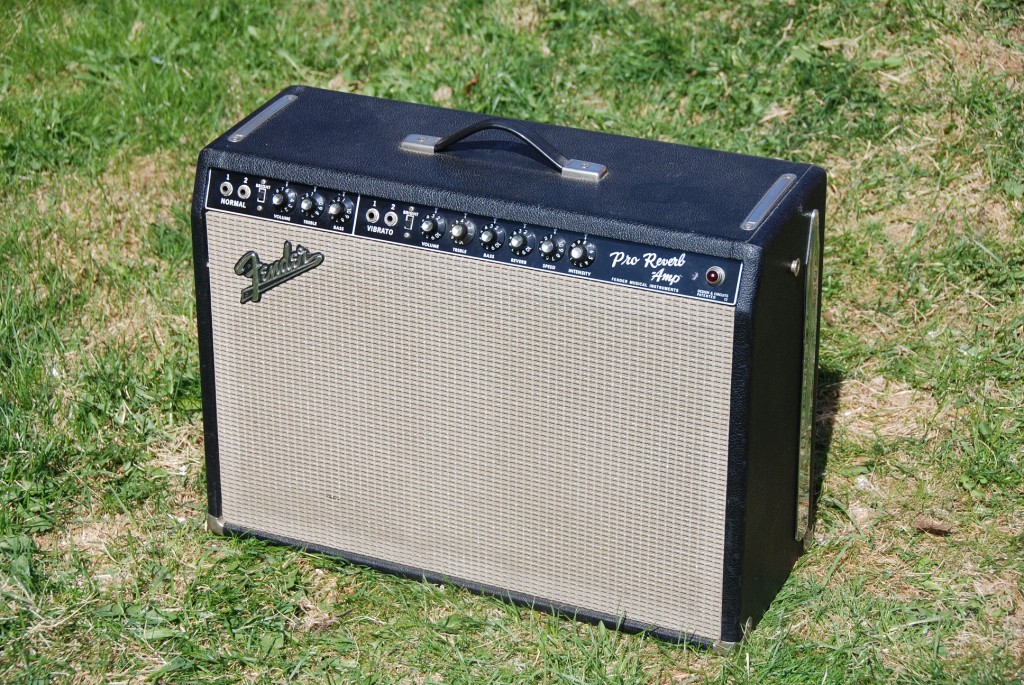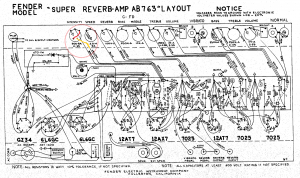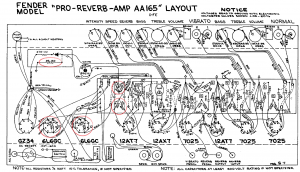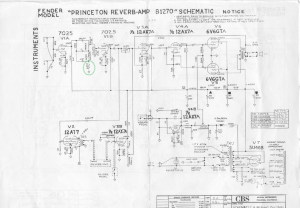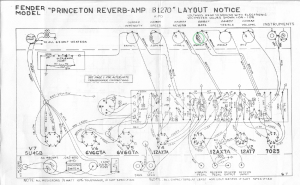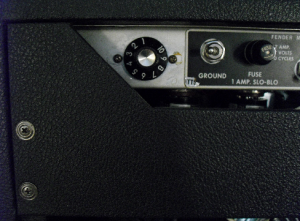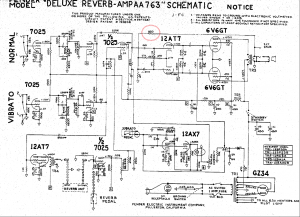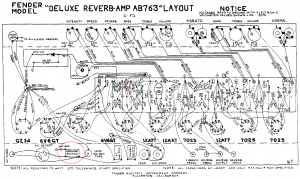Production years:
- 1964 -1967 blackface circuits AA165, AB668
- 1968 -1982 silverface circuits AA1069, AA1009, AA270
Tube layout
AA165 Tube layout (Seen from behind, V1 is to the right side)
- V1 12ax7 = Preamp normal channel
- V2 12ax7 = Preamp vibrato channel
- V3 12at7 = Reverb send
- V4 12ax7 = 1/2 Reverb recovery and 1/2 gain stage for vibrato channel
- V5 12ax7 = Vibrato
- V6 12at7 = Phase inverter
- V7 6L6 = Power tube #1
- V8 6L6 = Power tube #2
- V9 GZ34 = Rectifier tube
Summary
The Pro Reverb is one of the beloved 40W 6L6 working horses. It has the same 2×12″ speaker configuration as the Twin Reverb but has a less powerful amp. It has half the number of power tubes, smaller transformers and a tube rectifier in stead of diodes. Together this makes the Pro Reverb break up significantly around the usual volume level 4, while the Twin Reverb is clean almost all the way up. The power transformer and power tube circuitry is equal to the Super Reverb, but a smaller output transformer lowers the clean headroom and introduces sag and breakup. The amp is less powerful than both the Twin and Super Reverb and we’d place it somewehere between the Deluxe Reverb and Super Reverb. For many years it has been a relatively unknown amp. In the blackface and silverface years players wanted powerful amps, and the Pro Reverb was probably considered too weak. In modern times where low wattage breakup has become desirable, the Pro Reverb has become very popular.
The 2×12″ speaker configuration can deliver lots of punch and powerful mids that cut through with a good sound spread on stage. Different speakers may alter the tone significantly in the Pro Reverb, as in all amps. A set of Celestions give you a Britsh Marshall color with strong mids, while traditional Jensen-style speakers give you the classic Fender tone. Speakers are very difficult to recommend since the tone experience is nothing but personal taste. Like all silverface amps, the Pro Reverb was modified in the CBS periods to increase the clean headroom making it thinner and harder sounding.
Having an AB763-similar circuit, there are many mechanisms in the circuitry that you can tweak to suit your needs, basically to increase or decrease the clean headroom. Personally we like to mod the amp so we can make it smaller when needed. Tube mods (pulling V1 out and a 12ax7 PI) will take you a long way. If you also implement the tremolo disconnect mod you can really make the amp break up at practise volumes.
You’ll need schematics to implement some of these mods. http://www.ampwares.com/fender.asp. We usually start with explaining a mod from a functional perspective where we relate to components in the logical schematics diagram. Finally we point out location of components in the physical layout diagram.
Five fundamental tricks to create the holy grail of Fender tone
Here is a video demonstrating the effects of some of the mods and tricks described here. To see embedded text comments, go to video on Youtube.
Speakers
The easiest and most effective change you possibly can do to your amp. Tonewise, the speaker is the most important component in your amp. You may increase or decrease volume and color your tone significantly by swapping speakers.
The blackface Pro Reverb came originally with Jensen C12n, Oxford 12L6 or sometimes the Oxford 12T6 which is more often observed in the Twin Reverb. The Oxford 12T6 are exceptionally good speakers, a lot better than the 12L6 found in many Pro Reverbs and Deluxe Reverbs. They’ve got all what it takes, punch and sparkle.. The Jensen C12n are probably the most popular speakers both tonewise and in terms of robustness. In a 50 year old vintage amp the condition of the speakers varies a lot. To those who are both players and collectors we would recommend to recone vintage speakers if you’re not happy with the tone. You may experience that they sound even better than they originally did in the 60s and 70s.
Installing high or low efficient speakers depends totally on your need for volume. If your plans are to play the Pro Reverb with tube distortion at moderate volumes without beeing extremly loud (like the Twin Reverb), we recommend staying away from powerful and big sounding speakers (like EVM12L, Jensen C12N/K, Eminence Swamp Thang). In stead you should go for less efficient, “vintage” type speakers, perhaps with a dark frequency response if you are planning to play the amp beyond its sweet spot. Darker speakers tend to smoothen out the preamp and power amp tube distortion. For clean tone you should seek more neutral and transparent speakers. A nice trick is to pair different speakers, one vintage type and one more powerful. At some occasions we must admit that we get excited and fire up our Pro Reverb with speakers like EVM12L, Warehouse Veteran 30 or Eminence Swamp Thang. The punch of a big tone is amazing when coming from a big cabinet.
If you think your Pro Reverb is too loud you can easily disable one of the speakers for less volume and earlier breakup. Not only do you reduce the speaker areal and bass tones, the tubes are pushed harder since they see a 8 ohm load in stead of 4 ohm through the output transformer. You’ll achieve the amp’s sweet spot at a lower volume.
See page How to select speakers for general speaker recommendations.
Check this video to hear a stock 1966 blackface Pro Reverb with Jensen C12n (video on Youtube).
12AY7 or 12AT7 as preamp tubes – Less preamp gain.
If you want cleaner and spankier preamp distortion charcteristics, you may replace the V1 or V2 12AX7 preamp tube with 12AT7 and 12AY7. These tubes have different frequency responses than 12AX7, particurlarly when distorting. People describe these tubes to have less harsh and buzzy distortion. This mod does not alter the tone significantly when amp is played clean or when only the power amp section distorts. You’ll have to increase the volume setting to achieve a similar volume as before. The reason is that 12AX7 tube has a voltage gain factor = 100, while 12AT7 = 60 and 12AY7 = 45.
Pull out the V1 normal channel preamp tube – More preamp gain in vibrato channel
We’ll start with saying that this is a mod we personally do to all dual channel blackface, silverface and reissue amps. It is so easy to enable and disable that it can hardly be called a mod. If you are like most players and only use the Vibrato channel (reverb, tremolo, the bright cap and the extra gain stage), you should pull out the V1 tube. This is the preamp tube for the normal channel which you are not using when playing the Vibrato channel. Vice versa; If you’re using the Normal channel, you can pull out the V2 tube. All AB763-similar circuits (Deluxe Reverb, Super Reverb, Pro Reverb, Twin Reverb, Vibroverb, Vibrolux) are designed so that they share the cathode cap and resistor (25 uF/1500 ohm) and pulling one of the tubes will changes the effective value of the resistor they both share. If you pull one tube the other channel’s tube will be hotter biased and offers more gain. The amp will play louder than before given the same volume knob setting. The stronger signal will push the second gain stage (V4 tube) harder and give you increased sustain, compression and harmomics. This mod does not change the amp’s clean headroom but increases the preamp gain and preamp distortion.
This mod is one of Cesar Diaz’ tricks in the Fender Custom Shop Vibroverb 64 which he always did to Stevie’s amps. This mod is safe. It has stood the test of time and been been done by players in 50 years in blackface Fender amps.
Replace the 12AT7 PI tube with a 12AX7 or 12AU7 – Less clean headroom.
Very practical mod at practice and low volume environments. This mod reduces the amp’s clean headroom and you’ll achieve sweet spot at a lower volume. You’ll notice that the amp gets looser and with less attack. Tips: If you pulled the V1 12AX7 tube you may use it as V6 phase inverter.
12AX7 as phase inverer tube will give the most effect out of this mod. 12AU7 will be in between 12AT7 and 12AU7.
Replace the 12AT7 reverb driver with 12AU7 – Better reverb control.
Reverb is an important character with vintage amps, yet so individual and mysterious. We all know that speakers change their tonal character during age. So does the reverb. The reverb function sounds and behaves differently between “identical” vintage amps. Some amps have long, lush and soft reverb while others are mushy and overwhelming. We often find the reverb sweet spot around 2.5 on the reverb pot, varying from 2 to 4. Some amps are sensitive and difficult to control the reverb on. The whole dynamic area can be within a narrow interval, i.e. 2 and 2.5. These amps require a careful touch when dialling in the reverb, which irritates us.
The reverb circuitry consists of two tube sections (reverb driver V3 and reverb recovery V4) and the physical reverb tank. All these components will drift during age and minor differences in component values are noticeable to man’s ear.
If you replace the V3 12AT7 reverb driver with a 12AU7, you will reduce the effect of the reverb and it will be much easier to control with the reverb knob. So simple as that.
Use normal channel for reverb control – Adjust EQ and depth of reverb.
This mod is relevant only for two-channel amps with normal and vibrato channel. This trick is great for the reverb enthusiasts among us, and who is not? Plug your guitar into the vibrato channel, then unplug the reverb return cable on the back of the amp (the one that comes from the reverb tank output) and plug it into the normal channel input. You will need a converter to go from male phono/RCA jack to a 1/4″ male jack. You may now use the normal channel as a reverb control where you can adjust the depth and tone using the volume, bright switch, treble and bass knobs (and mid if you have a Twin Reverb). The reverb knob on the vibrato channel will have no effect any longer.
This mod is not applicable together with the Pull V1 mod, as you need the normal channel preamp tube.
Diode rectifier – More clean headroom.
This mod is for those who need more power, clean headroom and attack. It is very practical to carry with you those small Sovtek plastic adapters that quickly and easily replaces the rectifier tube. You’ll increase the power of the amp with a few watts. The diode rectifier will feed your amp’s filter caps with a higher and “faster” DC voltage compared to a tube rectifier. The fact that it delivers a slightly higher DC voltage to your power tubes (via the filter caps) means an increase of the tube voltage gain factor. When you hit a hard chord the preamp and power tubes will require energy and current is flowing from the DC filter caps which are charged up by the rectifier. If the recitifer can deliver more energy more quickly, you’ll have more power and attack.
Check also out Ted Weber’s “Copper Cap Rectifiers” that emulates the sag of a tube rectifier.
Rectifier tube
The silverface circuit AA270 has a 5U4GB rectifier tube in stead of GZ34, which all blackface circuits had. 5U4GB has less attack and more sag. You may choose to go with 5U4GB in all Pro Reverb circuits if you desire low wattage breakup before clean headroom.
Bigger output transformer
The Pro reverb has a smaller OT than other 6L6 BF/SF amps like Super Reverb and Vibroverb. When amp is pushed hard and close to the amp’s maximum clean headroom, the OT will not be able to transfer all energy ideally from the power tubes. There will be saturation and sag. If you want more power, clean headroom and attack from your Pro Reverb you may replace the original OT with one from a Twin Reverb or a Bassman head. The transformer must match the 4 ohm speaker impedance in the Pro Reverb’s 2×12″ configuration.
Tremolo disconnect mod – More preamp gain in vibrato channel.
The effect of this mod is similar to pulling the V1 normal channel preamp tube when playing the vibrato channel. This is also a very popular mod in AB763-similar circuits (Super, Twin, Virboverb, Pro Reverb, Deluxe, Vibrolux).
By original design the tremolo circuit will absorbe current/signal even when one turns the tremolo off with the footswitch. This mod suggests to entirly disconnect the tremolo circuit from the signal path by replacing the tremolo intensity pot with a switchabe pot (spst). One side effect with this mod is a noticable click and a volume difference between tremolo on and off using the new spst pot. If one uses the tremolo regularly one should still use the tremolo pedal to enable/disable the tremolo and leave the intensity spst pot at your desired level. The spst pot is not good for enabling and disabling the tremolo very often (because of the click and the volume difference) but is a nice when you play without tremolo. A good thing with this mod is that you have both the tremolo pedal and spst pot to use.
With a new switchable/spst pot set at intensity=0 the mod will kick in and raise the signal level in the preamp section, right before the phase inverter. Once you’re turning up the tremolo the circuit is connected again and the tone will remain original. This mod does not increase the amp’s clean headroom. We would describe the effect as making the tone richer, fuller and more powerful with stronger mids that pushes the power amp section harder (phase inverter + power tubes). We like this mod a lot for stratocasters wi the Fender AB763-similar circuits since they boost a relatively scooped and thin sounding guitar and amp. In addition to pulling the V1 tube, this mod is one of those must have mods which we never undo once having implemented it.
This mod is one of Cesar Diaz’ tricks in the Fender Custom Shop Vibroverb 64 which he always did to Stevie’s amps. This mod can be implemented in two ways, either by unsoldering the tremolo circuit or replacing the tremolo intensity pot with a swicthable pot, so-called SPST pot. The switch is enabled when you turn down intensity to zero. There are also switchable push/pull pots where you pull the knob to enable the switch.
- Order a 50k SPST from one of our recommended amp part dealers.
- Remove the original 50k trem intensity potmeter by unsoldering the wires to the potmeter lugs and unount the pot from the chassis. The black plastic wheel is to be used for the new pot.
- Install the new 50k SPST pot to the chassis. This is a switchable pot offering a mid positioned switch in addition to the variable resistanse 0-50KOhm between the lugs. At level=0 you’ll completly disconnect the tremolo circuit.
- See the wiring diagram below.
- You’ll have to solder the yellow wire to one side of the mid positioned switch in stead of to the right pot lug as before.
- Then solder a new (red) wire between the other side of switch to the right lug.
If you’re permanemtly disconnecting the tremolo circuit you can just clip of the brown and yellow wires and insulate the ends with tape. Note that the figure below shows the Super Reverb. The Pro Reverb would be the same.
(One may also use the tremolo pedal, in stead of the spst switch/pot, to entirly disconnect the tremolo. You will not need to replace the intensity pot with a spst, but let the yellow wire to the tremolo pot go through the tremolo pedal. In our opinion this is not a good idea since one loses the possibility to use both the spst switch and tremolo pedal. Using the pedal will now involve a significant click sound and volume increase.)
Blackfacing
The AA165 is the classic blackface circuit that many converts to. The following AB668 and AA270 were changed, but not dramatically. They both have some filter circuits (caps and resistors) areound the 6L6 power tubes to increase headroom and make the amp cleaner. This is easy to remove. The significant change in AA270 is the 5U4GB rectifier tube having less attack and more sag. You may choose to go with 5U4GB in all Pro Reverb circuits if you desire low wattage breakup before clean headroom.
We describe the differences between AA165 and the following circuit(s).
Changes in AB668:
- New power transformer producing a higher plate voltage to the 6L6 tubes (465V vs 440V). This means more clean headroom in Ab668.
- 6L6 power tubes had 150 ohm resistors installed between ground and cathode. Also a 25uF/25v cap was installed between the tubes’ cathode. This is pin 8.
- 6L6 tubes had 2000pF caps installed between ground and control grids (pin 5) to filter out high frequencies. This will result in a cleaner tone.
- 220kOhm grid resistors on 6L6 tubes were replaced by 100kOhm.
- Resistor changes in dc voltage dividor circuity. The 1kOhm resistor was replaced by a 4,7KOhm resistor. The 10kOhm was replaced by a 4,7KOhm.
- Bias electrolytic cap was changed from 25uF/50V to 50uF/70V in AB568. Tone not affected.
- The bias circuit was changed with separate wires to each of the 6L6 tubes and resistor values changed.
- Phase inverter plate resistors changed from 82K/100K to 47K/47K.
Logical schematics (showing the AB668):
Layout (showing the AA165 with larger circles around the 6L6 tubes having several changes):
Click images for full size versions.
Changes in AA270 (from AB668, we list only significant changes):
- The 150 ohm resistors and 25uF/25v caps on 6L6 cathodes were removed (like it originally was in AA165)
- The resistors in dc voltage dividor circuity were changed back to AA165 specs; 1 KOhm + 4,7 KOhm.
- The GZ34 rectifier tube was replaced by 5U4GB which has more sag and less attack.
- Mid cap in EQ circuit for both normal and vibrato channel was changed from 0.047uF to 0.022uF. This means more mids with the 0.022uF since less signal leaks to ground through that cap and the 6,8KOhm resistor. Our recommendation is the lower cap value that allows more beefy tones. If you seek a scooped tone with less mids, go with the higher cap value. This cap is marked with a red circle at the left most side in the figure below, on both channels.
Middle pot
The Pro Reverb did unfortunatley come without a mid pot. Many players are happy with the default 6.8K mid resistor in the EQ circuitry, but some want what the others have; a 10K potmeter mounted in series with the 6.8 Kohm resistor. When the potmeter is set at 0 you’ll have an original tone, and when turned up the mids increases and your amp growls with a British Vox’ish tone (especially together with a Celestion speaker). For a wider tone range you can replace the 6.8 KOhm resistor with a 4 KOhm, and use the 10 K pot to go beyond the original 6.8 KOhm and up to 14 KOhm. If you do not use the reverb or tremolo pedal it is very practical to install the middle pot here. It requires a simple solder and removal job to replace the phono plugs with a mid pot. Or you could install the mid pot at the left most side of back of the amp where the additional power supply is located.
Logical schematics (Princeton Reverb, but equally for Pro Reverb)
Layout
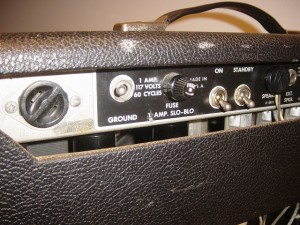
Negative feedback loop
The negative feedback loop can easily be tweaked to alter the treble cut and distortion in your amp. The purpose of the NBF loop is to clean up the tone and cancel out the mid/higher frequencies and upper harmonics (distortion) at the entry point of the phase inverter which is placed in front of the power tubes. The NBF theory is that you take the signal from the speaker output, let it go through a resistor and mix it in at the entry point of the phase inverter. The speaker signal is out of phase (180 degrees) with the signal at the entry point of the phase inverter and will cancel out equal frequencies. If you disconnect the NBF loop you’ll notice that the volume increases and tone gets much more aggressive. More white noise too. unfortunately, which is why there is a NFB loop. You will fin the amp’s sweet spot at a lower volume knob setting without the NFB loop. Not only is there a volume shift, the amp’s clean headroom is reduced slightly. Most importantly the tone gets rougher and rawer with more mids and higher frequencies, aka presence. If you think your tone is too bright or harsh or you’re seeking a mellow and nice clean tone, you probably want to keep the NBF loop. This mod is for those who want more bite and a tone that really cuts through in the mix.
You may choose to implement the mod in several ways and in various combinations with the ground switch or a foot pedal. A foot pedal works like a boost/FAT pedal. If yo’re struggling to find a transparent boost pedal that keeps the natural Fender tone you should try this out. You will still have that beautiful Fender tone, just more and wilder.
- No negative feedback at all. Simply disconnect the feedback loop (a wire) and tape insulate it. You get the most effect of this mod by disconnecting the NFB loop entirely. You may experience that the tone gets harsh, depending on guitar, speakers and EQ settings of course. If so, read more about the cap in the next bullet point.
- Keep the feedback loop and install a .01 µF in series with the NBF resistor. This cap will prevent the lower and mid frequencies to go through the NFB loop. Depending on the cap value treble frequencies will be fed back to the phase inverter which cancels out the treble in the main path. The tone gets less harsh and you still have a noticable effect. You should experiment with different cap values. Start with 0.01µF.
- Increase the feedback loop resistance value. A good starting point is around 1.5 and 3 KOhm. This reduces the effect of the feedback loop, making the amp break up more when the NFB is engaged. If you make the NBF switchable there will be less volume difference if you use a high resistor value. (Using a .01 µF cap is also recommended to minimize the difference a little bit between NBF on and off).
- Use the ground switch or foot pedal to make the NBF switchable. If you remove the death cap and free up the ground switch by removing existing wires to it (if you’re wondering what the ground switch does, you don’t need it). Then wire the ground switch in series with the NBF resistor. If you’re using a cap in the NBF loop this goes across the switch allowing treble to bypass independent of the switch. When the ground switch has disconnected the NBF loop the higher frequencies are still fed back through the cap. In practice you solder each the two cap legs to at each side of the switch between speaker terminal and NFB resistor.
Where to install footpedal or switch? The ground switch is easy available if you disable the power supply wires and death cap. For amps with reverb you could use the reverb footswitch phono plug if you are not using it.
Logical schematics (for Deluxe Reverb, but similar with Pro Reverb)
Layout (for Deluxe Reverb, but similar with Pro Reverb)
Click images for full size versions.
Mulitiple and flexible speaker output impedances (built-in attenuator)
This mod requires the knowledge of how to replace a transformer in your amp. The mod will give you mulitiple and flexible speaker output impedances where the external speaker output jack serves as a secondary independently speaker output. This flexibility is desirable for both 1×12? or 2×10? speaker configurations together with extension cabinets.
The original OT in a Pro is sized for a 4 Ohm speaker impedance (2×12? @ 8 ohm). It will make sure the power tubes “see” the correct impedance and can operate at optimal conditions in terms of clean headroom potential and frequency response. If you were to replace the original OT with a 2 ohm OT, the tubes will be pushed harder since they see a bigger load than expected (the tubes see the speakers through the OT). Both the volume and clean headroom will be reduced, yet the tone stays fairly the same (some clarity may be lost). This effect is similar to an attenuator, which is very nice when you want to achieve the amp’s sweet spot at a lower volume.
- In a 2×12? @ 8 ohm speaker configuration, we recommend 4 ohm + 2 ohm output impedances.
- In a 1×12? 2 8 ohm speaker configuration, we recommend 8 ohm + 2 ohm output impedances.
- Go to Mercury Magnetics web site. Order the Pro Reverb multi-tap OT with 2, 4 and 8 ohm taps.
- Remove the original OT carefully and store it away. Install the Mercury Magnetics OT.
- Wire the OT’s primary circuit just as before. Clip the cables nicely and twist them as Leo Fender’s gently old ladies did. Insulate the unused ones with tape.
- The OT’s secondary circuit will be wired differently. Wire the 4 ohm tap to the main speaker jack. Then wire the 2 tap to the ext speaker jack. You must first remove all existing wiring on the external speaker jack so that it is totally separated from the main speaker jack.
- Now you have two speaker outputs; 4 ohm + 2 ohm. You may use them independently and the ext speaker jack does not require the main speaker jack to be plugged.
We like this mod a lot. Especially since we’re using the original jack outputs. Choosing the 2 ohm output with two 8 ohm speakers (4 ohm) in will attenuate the volume a lot at practise and gigs.

